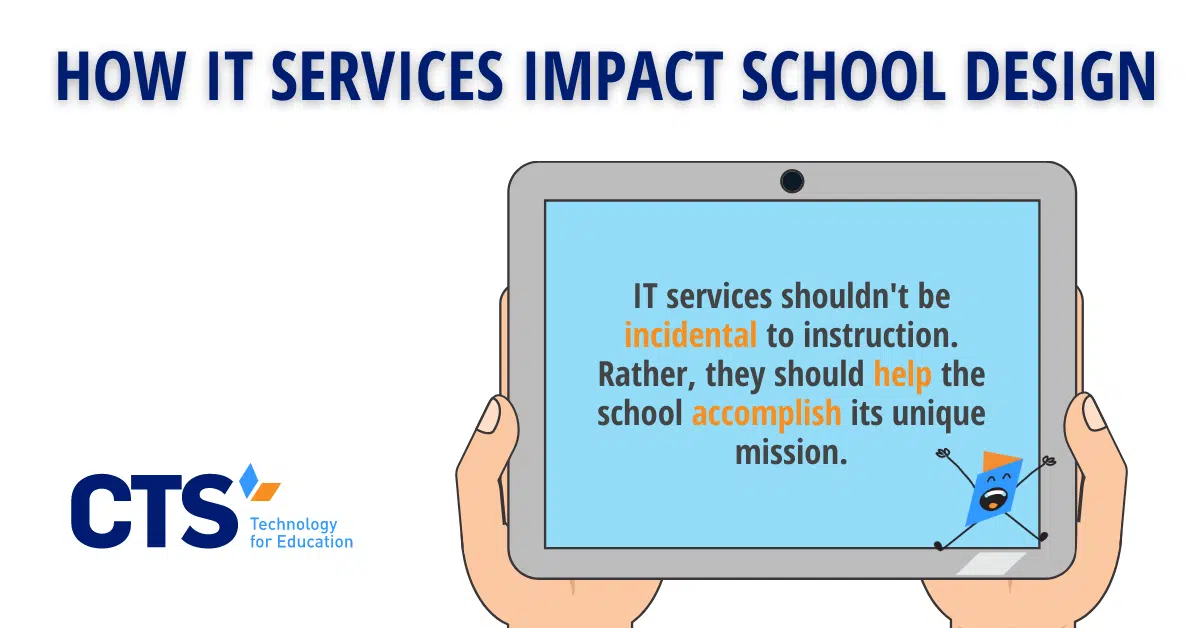IT services have a dramatic impact on school design.
Technology increasingly dominates students’, teachers’, and school leaders’ educational experience. From Chromebooks and staff laptops to projectors, SMART boards, and online instructional platforms, schools regularly deploy technology to accomplish their instructional goals.
These goals, in turn, influence the extent to which the school uses technology to educate students. Suppose a school wants to increase its students’ reading performance on an upcoming state assessment. In that case, it might invest money in an online instructional platform or data and assessment system targeted to specific English Language Arts standards. By contrast, a school that wants to create more experiential learning opportunities for students might invest in virtual reality headsets, a robotics lab, or a learning management system that allows students to collaborate more easily with one another online.
Regardless of its specific form, the relationship between IT services and school design dramatically impacts instruction. When done correctly, IT services allow schools to use technology in a way that adds significant value to instructional programming. Technology shouldn’t be incidental to the school’s broader instructional goals but should instead be used strategically as one element in the overall school design.
It’s critical to engage an IT service provider early in the school design process.
For schools opening their doors for the first time, engaging a managed IT service provider early in the planning process is critical to a successful launch.
First, engaging a managed IT provider early allows the school to nail down, with specificity, the extent to which technology will be used in daily instruction. Answering this question is more complicated than it may sound: for instance, if the school wants every student to have their own Chromebook, it will have to make a significant investment in student devices and charging carts. Similarly, suppose the school chooses one operating system for its staff devices but another for its student laptops. In that case, it will have to think through the implications of that decision for student-teacher collaboration.
Once the scope of the school’s technology use is determined, the school can then work with the managed IT provider to source and place orders for all of the technology the school will need for daily instruction. Because of the high demand for educational technology, it simply won’t do to place these orders at the last minute, especially for hot commodities like student Chromebooks. The managed IT provider can find the most cost effective vendor for the technology and manage the ordering process in a way that ensures all of the school’s technology arrives by opening day.
Finally, once the technology arrives at the school, the managed IT provider can oversee set-up and installation and, on a longer-term basis, field daily troubleshooting requests. Because technology issues inevitably arise, it’s important that the school has someone on staff or a “hotline” teachers and administrators can call to resolve technology-related issues. This ongoing support not only ensures the school’s technology remains viable but also alleviates significant stress from teachers and administrators who already have a lot on their plates.
Effective IT services marry technology use with instructional design.
Effective IT services don’t just keep the school’s technology running, however. Instead, high-quality managed IT providers help their school partners use technology to accomplish their instructional goals. It’s not enough that the school’s Chromebooks all work properly or that each classroom has the latest SMARTboard model. The school’s technology use should instead tie back directly to its instructional goals and broader academic mission.
For example, an arts-based middle school might want to invest in graphic design platforms or other digital art programming based on student interests, while a STEM-focused high school might choose to invest in a “coding lab” for student use. In both cases, the school decides to deploy technology in a way that accomplishes its unique instructional goals. Understanding these goals, developing a technology program that fits within them, and mobilizing technology resources accordingly is a hallmark of effective IT services.
When a school leader chooses to purchase a specific piece of technology, they should be able to tie that purchasing decision back to the school’s broader instructional vision.
At CTS, we help school leaders use technology to accomplish their unique mission.
Our team has worked with more than 60 schools across the United States to use technology to accomplish their unique missions. Technology shouldn’t be incidental to the school’s mission. Rather, it should add value to instructional programming and be used strategically to accomplish specific instructional goals. By sitting down with school leaders and understanding their technology vision, we provide technology solutions that go above and beyond other managed IT providers. Contact us today to learn more about our services and how we can help your school accomplish its unique mission.




